25 People’s Choice Photos for Wildlife Photographer of the Year 2021
![]()
The Wildlife Photographer of the Year competition hosted by the Natural History Museum has shortlisted 25 photos that are now up for the People’s Choice Award.
Wildlife Photographer of the Year positions itself as a global platform for amateur and professional photographers and the photos featured in its competition are seen by millions of people worldwide. The 2021 competition saw over 50,000 photos entered from 95 different countries. The 25 images below are currently on display at the Wildlife Photographer of the Year exhibition at the Natural History Museum in London, until the voting ends on February 2, 2022. The winner will then be showcased until the exhibition closes on June 5, 2022.
The top five People’s Choice Award images will also be displayed online, joining the winners of the fifty-seventh Wildlife Photographer of the Year competition chosen by the panel of judges and announced earlier this year.
The 25 photos below are up for a public vote on the Natural History Museum’s website.

It is a two-hour helicopter ride from the nearest town to this spot on the Fishing Branch River in Yukon, Canada – a location where the river never freezes however cold it gets. The salmon run occurs in the late autumn here and for the grizzly bears of the area this open water offers a final chance to feast before hibernating. It was averaging around -30°C (-22°F) and Andy had been waiting and hoping that one particular female bear would use this log to cross the stream. Eventually she did just that and he got the picture he’d envisioned – her fur, wet from fishing, had frozen into icicles and ‘you could hear them tinkle as she walked past’.

Iberian lynx are one of the world’s most endangered cats due to habitat loss, decreasing food sources, car hits and illegal hunting. But thanks to conservation efforts the species is recovering and can be found in small areas of Portugal and Spain. Antonio captured this image while leading a conservation project based around photography in Peñalajo, Castilla La Mancha, Spain. He knew a family of lynx used this waterhole to drink, so he rigged up a hide close by. Focusing on this cub, he was lucky enough to capture the moment it lifted its head from the water, licked its lips and gazed straight into the camera.

During a visit to the Maasai Mara, Kenya, Ashleigh captured this tender moment between a pair of male lions. At first, she had been taking pictures of only one of the lions, and the rain was just a light sprinkle, although the second had briefly approached and greeted his companion before choosing to walk away. But as the rain turned into a heavy downpour, the second male returned and sat, positioning his body as if to shelter the other. Shortly after they rubbed faces and continued to sit nuzzling for some time. Ashleigh stayed watching them until the rain was falling so hard that they were barely visible.

Santa Croce Lake is a natural lake located in the province of Belluno, Italy. In winter 2019 Cristiano noticed the water was unusually high and the willow plants were partially submerged, creating a play of light and reflections. Waiting for colder conditions he captured the scene in icy stillness. After taking the image, he was reminded of a dear friend, who had loved this place and is now no longer here, “I want to think he made me feel this feeling that I’ll never forget. For this reason, this photograph is dedicated to him”.
![]()
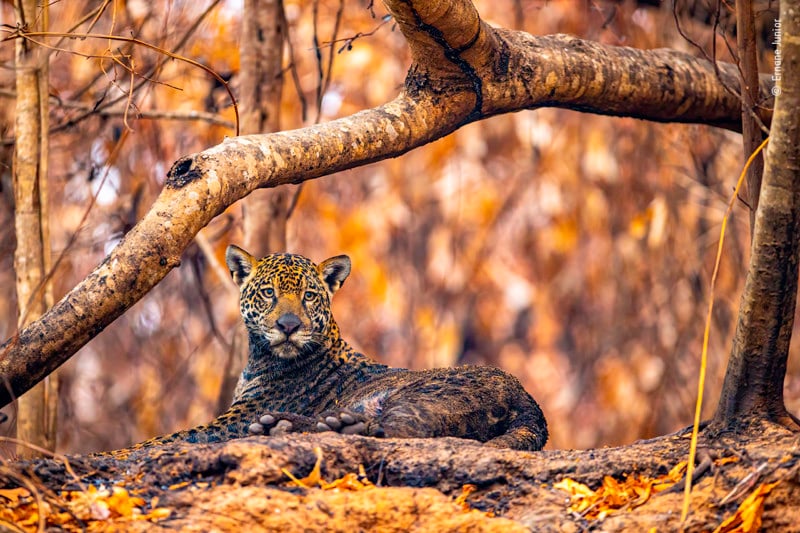
The year 2020 saw fires in Brazil’s Pantanal wetlands more than double compared to the year before – ‘a year never to be forgotten’ says Ernane. More than 26 per cent of the total area was affected, and the situation in Encontros das Águas State Park was even worse, with roughly 80 per cent burnt. The park is known for its large jaguar population and Ernane was there documenting the fires when this jaguar and his brother crossed the Rio Três Irmãos (Three Brothers River) nearby. After reaching the opposite bank, the jaguar rolled in the ash left behind by the desolation of days before, leaving only his face uncovered, his now black body mirroring his charred surroundings.

Jaime watched on as Federico Mosquera, a biologist from the Omacha Foundation, Colombia, soothed an Amazon river dolphin. These dolphins are extremely tactile animals and direct contact calms them – keeping them hydrated when out of the water is also extremely important. The team from Omacha and WWF were transporting the dolphin to a temporary veterinarian facility in Puerto Nariño, Colombia, to install a GPS tag in its dorsal fin. The project is part of a broader scientific attempt to understand river dolphin health and migratory patterns. The goal was to tag five individuals, but high waters gave the dolphins a wider roaming range than usual, and the crew struggled, tagging only one during the expedition.

Jan took great pleasure in watching this blackbird from his front door, in his home-town of Greifswald, Germany. It was spring and the blackbird had chosen an old garden hut in which to build her nest. Quietly and secretly she raised her young in this garden idyll. With this image Jan wanted to highlight that we don’t have to go far to experience the beauty of nature – sometimes something as simple as a blackbird making her home in a rundown hut is enough.
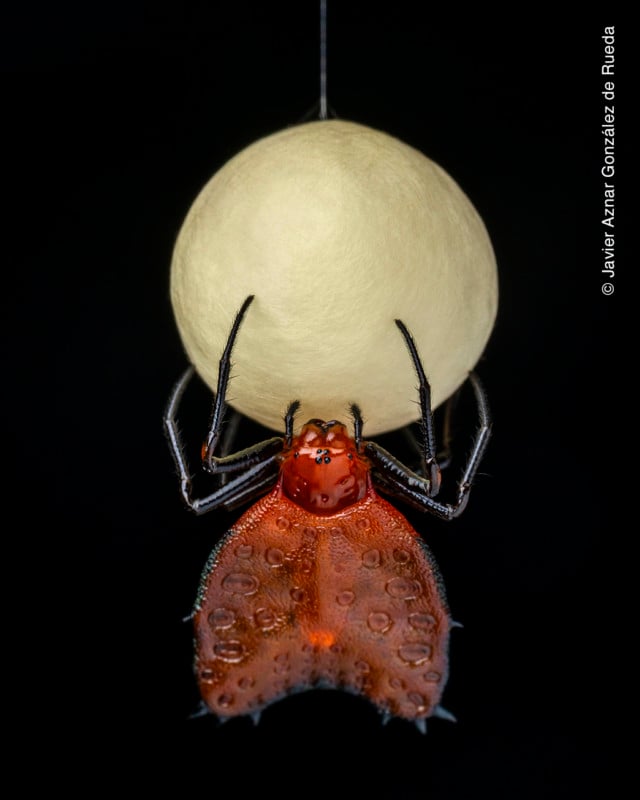
While out on a night walk in the Amazon rainforest near Tena, Ecuador, Javier spotted this little female thorned heart orb weaver spider delicately constructing her egg case. Hanging from a strong silk thread, these female spiders spend hours encasing their eggs in a silken cocoon, which may contain up to several hundred eggs. On this dark night, the egg case resembled a pearly white full moon.

Black bear cubs will often climb trees, where they wait safely for their mother to return with food. Here, in the depths of the temperate rainforest of Anan in Alaska, this little cub decided to take an afternoon nap on a moss-covered branch under the watchful eye of a juvenile bald eagle. The eagle had been sitting in this pine tree for hours and Jeroen found the situation extraordinary. He quickly set out to capture the scene from eye-level and, with some difficulty and a lot of luck, was able to position himself a bit higher on the hill and take this image as the bear slept on, unaware.
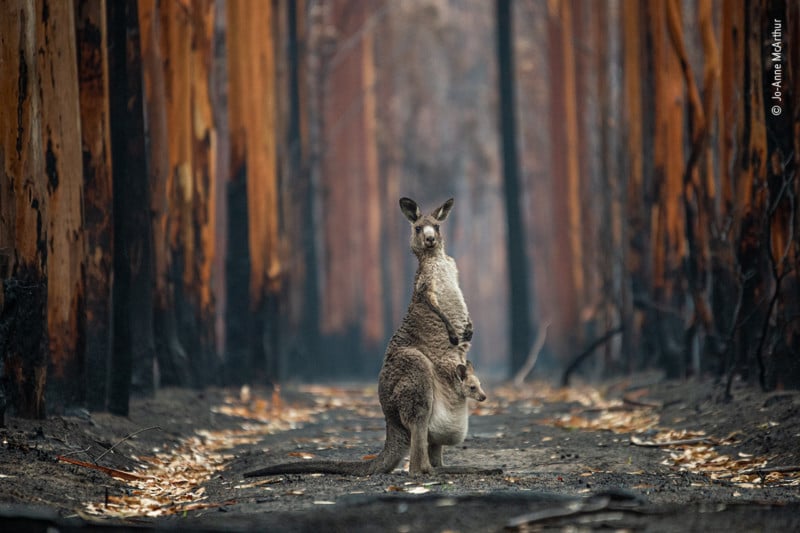
Jo-Anne flew to Australia in early 2020 to document the stories of animals affected by the devastating bushfires that were sweeping through the states of New South Wales and Victoria. Working exhaustively alongside Animals Australia (an animal protection organisation) she was given access to burn sites, rescues and veterinary missions. This eastern grey kangaroo and her joey pictured near Mallacoota, Victoria, were among the lucky ones. The kangaroo barely took her eyes off Jo-Anne as she walked calmly to the spot where she could get a great photo. She had just enough time to crouch down and press the shutter release before the kangaroo hopped away into the burned eucalyptus plantation.

Due to overexploitation – industrial logging and land clearing for plantation development – the rainforests of Borneo are disappearing fast. Because of this, endemic species like the orangutan are suffering and dying because of habitat loss and are under serious threat. International Animal Rescue conducts the laudable task of rehabilitating orphaned or injured orangutans. They give them the health care they need and prepare them for reintroduction, when possible. Here, in a forest enclosure, a keeper takes care of babies – they are encouraged to mix with others of a similar age, make nests and forage for food.

Karl was in the Cairngorms, Scotland, with a friend who took him to a forest where red squirrels were used to being fed. They placed hazelnuts on opposite branches of two trees and Karl then positioned his camera on a tripod between the branches facing the direction a squirrel might jump. Setting his camera to automatic focus, he waited in camouflage gear behind a tree, holding a remote control. After less than an hour, two squirrels appeared. As they leapt between the branches, he used the high-speed burst mode on his camera, and of the 150 frames, four were sharp, and this one perfectly captured the moment.
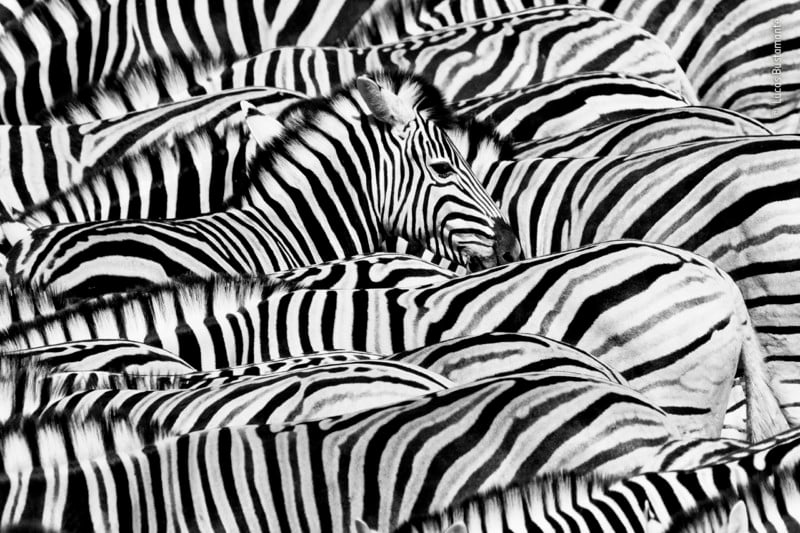
Dozens of plains zebra had showed up to drink at Okaukuejo waterhole in Etosha National Park, Namibia – a popular location for the animals of the area to quench their thirst caused by the searing heat of the sun. Packed closely together and moving as one, the zebra lowered their heads to get water and, almost immediately, robotically lifted them again to scan for danger. This went on for five minutes and their stripes reminded Lucas of a living barcode. Focusing hard, his aim was to capture only one with its head up and, just before the herd left, he got the image he thinks best showcases these iconic black-and-white striped animals.

The Clark’s grebes on Ly’s local lake in San Diego, California, USA, hadn’t nested for a few years, and he wasn’t sure if the unusually hot and dry weather they’d been experiencing was to blame. Then in 2017 California had twice its normal annual rainfall. With the lakes full, the grebes started to build nests and lay eggs again. They build floating nests at the edge of shallow water among the reeds or rushes. The chicks hitch a cosy ride on a parent’s back soon after hatching. This picture was taken a few days after a storm which sadly washed away almost all of the grebes nests. Ly had been out on a boat for hours, scanning the surface, looking for grebes and, just as the light was fading, he spotted them, the survivors.

Marco was watching this little Arctic fox as it incessantly called another nearby. Gradually he noticed the fox’s wet breath was quickly freezing in the air after each call. It was late winter in Spitsbergen, Svalbard, and the cold arctic air was -35°C (-31°F). Photographing arctic foxes is often frustrating, as they are normally running around fast in search of food, but this one was very relaxed and let Marco get close enough to focus on it, with the light glowing perfectly in the background.

Taking care of a young orangutan requires a lot of energy. Maxime spent more than one hour observing this mother in the Pinus Jantho Nature Reserve of Sumatra, Indonesia, trying to keep her excitable baby with her in the nest. Since 2011 the Sumatran Orangutan Conservation Program has released more than 120 confiscated apes into the reserve. Their goal is to establish new wild populations as a safety net against decline. This mother, Marconi, was once held captive as an illegal pet, but was nursed back to health and released in 2011. In 2017 she was spotted with a wild born baby, Masen, a symbol of hope for the future population.

Michiel took this photo of Dantita, as she is fondly known, at the foothills of Braulio Carrillo National Park, close to San José in central Costa Rica. The Baird’s tapir or ‘gardeners of the forest’ are extremely important to their natural habitat, with some seeds only germinating after passing through the tapir. But due to threats from deforestation and hunting, there are estimated to be only 6,000 individuals left in the wild. Conservation groups such as Proyecto Tapir Nicaragua and Nai Conservation have been set up to work closely with local communities to promote the importance of preserving the land and protecting an endangered species.

There were several big trees near Minghui’s hotel in the Xishuangbanna Tropical Botanical Garden in Yunnan Province, China, and he’d noticed green tree ants on the trunks and was fascinated by their behaviour. This species of ant builds its nest in the tree crown, are ferocious by nature and good at catching all kinds of insects. One morning Minghui noticed a group of ants working together in perfect unity to restrain a green katydid. These remarkable ants don’t always kill, they have been observed ‘farming’ certain types of insects, including leaf hoppers. The ants offer leaf hoppers protection from predators and parasites so that they can feed on the sweet sap the leaf hoppers excrete.

Peter looked on as a herd of elephants closed ranks, pushing their young into the middle of the group for protection. A bull elephant had been trying to separate a newborn calf from its mother. Peter was photographing the herd in Addo Elephant Reserve, South Africa, when the newborn let out a shriek. The herd reacted instantly – blowing loud calls, flapping ears and then surrounding the young and reaching out their trunks for reassurance. Elephants create bonds that last a lifetime, and they can show emotions from love to anger. Peter feels ‘There is something magical and beautiful when you observe elephants – it touches your soul and pulls at your heartstrings.’

In the Lishan Nature Reserve in Shanxi Province, China, Qiang watched as two male golden pheasants continuously swapped places on this trunk – their movements akin to a silent dance in the snow. The birds are native to China, where they inhabit dense forests in mountainous regions. Although brightly coloured, they are shy and difficult to spot, spending most of their time foraging for food on the dark forest floor, only flying to evade predators or to roost in very high trees during the night.

This group of meerkats in the Tswalu Kalahari Reserve in South Africa has been habituated to humans for over a decade, and is very relaxed around people. In fact, they mostly completely ignored Thomas’s presence, being way too preoccupied with lounging, hunting, grooming and fighting. He was therefore able to get in close and use a wide angle lens to include the arid savannah and mountains they call home. To capture the meercats features, he applied techniques used for people in a portrait session, and used studio lights to photograph them.

A female giant anteater was foraging around a huge open plain very late one afternoon in the Pantanal, Brazil, when Wim suddenly noticed she had a youngster on her back. He instinctively grabbed his camera and slowly crept up to a termite mound in the distance, which was in the general direction she was moving in. Sitting quietly he waited for her to make her way over. But the light was fading quickly, and he began to wonder if he’d have time to capture the scene. After waiting quite some time – anteaters walk slowly – and holding some very heavy camera equipment, Wim was rewarded for his patience.

It was the schooling barracudas at Blue Corner, Palau, in the western Pacific, that grabbed Yung’s attention while diving in the turquoise seascape. He had been swimming with them for four days, but their formation constantly changed shape and he could not find the perfect angle. On the fifth day his luck changed when the fish seemed to accept him into the group. Surrounded by the barracudas, he started to imagine how one fish sees another while swimming, and this was the picture he wanted. The fish were fast, and he had to swim hard to keep his place in the school. At the end of an exhausting 50 minutes, he got his perfect ‘fish eye’ view.
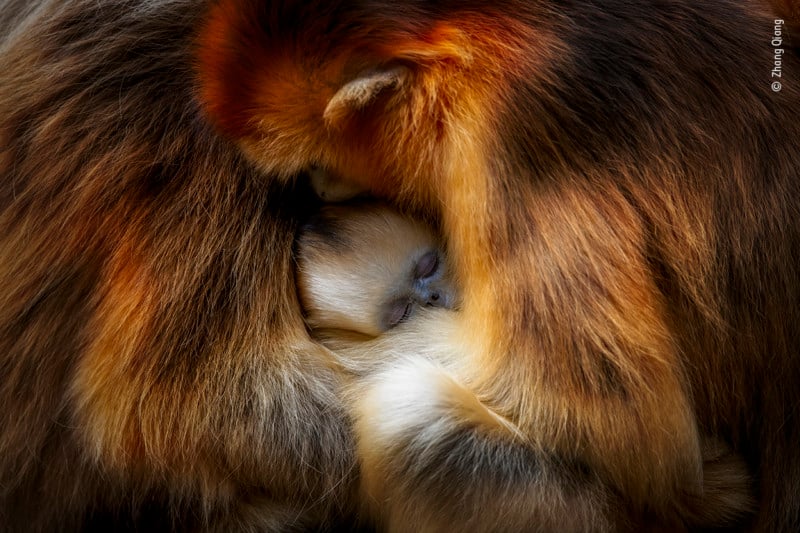
Zhang was visiting China’s Qinling Mountains to observe the behaviour of the Sichuan snub-nosed monkey. The mountains’ temperate forests are the endangered monkeys’ only habitat, which in itself is under threat from forest disturbance. Zhang loves to watch the dynamics of the family group – how close and friendly they are to each other. And when it is time to rest, the females and young huddle together for warmth and protection. This image perfectly captures that moment of intimacy. The young monkey’s unmistakable blue face nestled inbetween two females, their striking golden-orange fur dappled in light.
While the vote for People’s Choice is ongoing, the 58th annual competition will close for entries on December 8. Those interested in entering can do so and read the official rules on the Wildlife Photographer of the Year website.
Image credits: All photos individually credited and provided courtesy of the Natural History Museum and the Wildlife Photographer of the Year competition.
from PetaPixel https://ift.tt/3d3uQUz
via IFTTT
Comentarios
Publicar un comentario